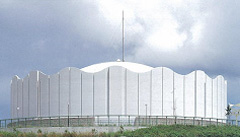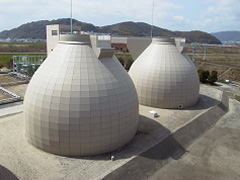PC Tank
Circular PC Tank
Since we constructed Japan's first prestressed concrete (PC) tank, the Koyasu adjustment water tank in Kanagawa prefecture, in 1958, we have constructed many PC tanks all over Japan. These tanks feature increasingly improved technologies that take advantage of the properties of PC. We construct PC tanks with various designs that have economic, durability, and earthquake-resistance performance, such as waterworks and sewage facilities; tanks for oil and liquid natural gas; and silos for cement, grains, and farms.

Double-cylinder type waterworks storage PC tank (Capacity: 13,300 tons)
Features
- PC tanks are water-tight due to prestressing in the circumferential and vertical directions, which means crack-free tank walls.
- Maintenance costs are minimized due to PC durability, which results from the lack of cracking.
- PC tanks have anti-earthquake performance because the PC structure is prestressed in the circumferential and vertical directions.
- PC tanks have a shorter construction period and a lower construction cost due to the PC structure allowing the tank wall to be thinner.
- PC tanks can suppress increased water temperature in the summer due to its insulation property compared with steel water tanks.
PC Egg-shaped Digestion Tank
We introduced a PC egg-shaped digestion tank, called Dywidag, which was developed by Dyckerhoff & Widmann AG, to Japan and redesigned it as an anti-earthquake structure according to Japanese geotechnical conditions. The PC egg-shaped digestion tank has changed the function of sludge treatment of the digesting tank from energy consumption to energy generation with less manpower. We have been considering and improving new forms for construction due to complex structures with prestressed steel in dual directions and curvature in the horizontal and vertical directions.

PC Egg-shaped Digestion Tanks (Capacity: 4,000 m3)
Features
- Accumulation of sand inside the tank is avoided by a steep slope at the tank bottom.
- Even highly concentrated sludge can be stirred because the smooth curved structure inside the tank provides good stirring efficiency.
- Heating costs are reduced because the smaller surface area suppresses the radiation of heat energy away from the tank.
- The total cost is reduced compared with conventional reinforced-concrete digestion tanks due to the PC structure, which can support a larger tank size.







